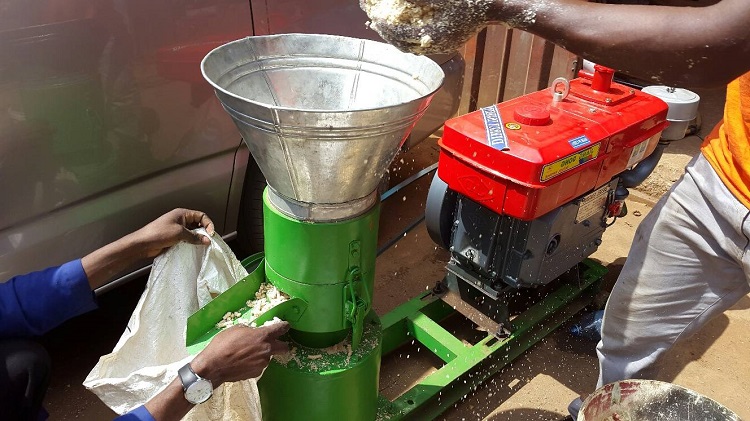Jolly Mary Kabirizi is a farmer and scientist at Kyakuwa Farm Clinic. At the farm, she uses a pelleting machine to produce dairy cow and calf pellets on a commercial basis.
Kabirizi says the raw materials used in the production of pellets depend on the quality or feeding value, cost, and availability.
She says she chops the raw materials or crop residue into one-centimeter-long pieces using a motorized feed hammer mill to get fine ground ingredients. She then mixes the ingredients in a feed pellet blender for some time to get a uniform mix. She uses molasses of approximately 10 percent as a binder and adds it to the mixture to obtain a moist, cohesive mash at the end of the final mixing.
“After mixing, the mash is delivered to the pellet mill feeder. It is fed into the feed pellet mill and then to the roller and extruder die. When the mash is compacted through the die, I get soft, moist pellets formed for feeding cows,” Kabirizi explains, adding that the wet pellets are spread out and air dried to obtain moisture content below 12 percent and that drying can be done in a simple solar drier.
How the machine works
Hadad Ssebunza, the technical sales manager at Musa Body Machinery Uganda that makes pelleting machines in Katwe, a Kampala suburb refers to the pelleting machine as a unique tool that serves a number of purposes. “If you feed the machine with any kind of grass as long as it has no soil for processing, it still comes out green and can be kept for as long as four years without going bad. The processed feeds can be fed to animals such as cows, pigs, and poultry,” Ssebunza explains. A 2013 invention by two institutions, Musa Body Machinery and National Agricultural Research Organisation (NARO), Ssebunza says the main purpose of the pelleting machine is mainly to process animal grass that can last for a much longer time, compared to animal feeds such as hay.
When you have the machine, Ssebunza says you may not need big chunks of land for grazing. He says you only need shelters where animals stay.
Like some farm machines, Ssebunza says the pellet mill machine runs on a diesel-powered engine. In one hour, it can produce between 200 to 300 kilograms of feeds and that this is obtained on one liter of fuel. You just need space of three by three (3×3) meters that can accommodate the feeds to be processed and the machine.
It is in small and bigger sizes, with the small one costing Shs4m and the bigger one costing Shs15m.

